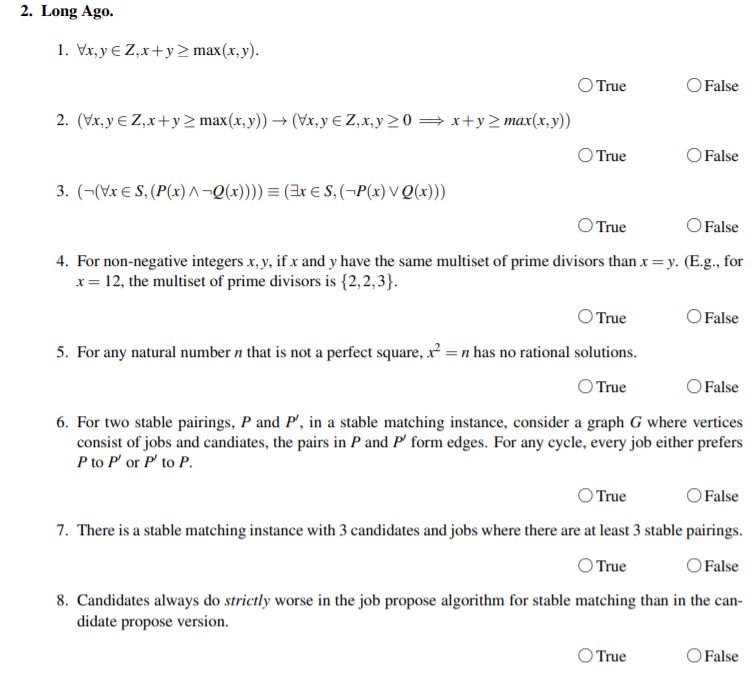Help me. Thanks for your help!!!
2. Long Ago. 1. Vx, y EZ,x + y > max(x,y). O True False 2. (Vx, y EZ,x + y > max(x,y)) - (Vx.y EZ,x,y 20 => x+y > max(x,y)) O True OFalse 3. (-(VxES, (P(x) A-Q(x)))) = (3res, (-P(x) ve(x))) O True OFalse 4. For non-negative integers x, y, if x and y have the same multiset of prime divisors than x = y. (E.g., for x =12, the multiset of prime divisors is {2, 2,3}. O True OFalse 5. For any natural number n that is not a perfect square, x- = n has no rational solutions. O True OFalse 6. For two stable pairings, P and P', in a stable matching instance, consider a graph G where vertices consist of jobs and candiates, the pairs in P and P' form edges. For any cycle, every job either prefers P to P' or P' to P. O True OFalse 7. There is a stable matching instance with 3 candidates and jobs where there are at least 3 stable pairings. O True OFalse 8. Candidates always do strictly worse in the job propose algorithm for stable matching than in the can- didate propose version. O True OFalseVariance, Covariance . Def (Var): For a r.v. X with E[X] = M, then var(X) = E[(X - u)2], and the standard deviation of X is o(X) = Vvar(X) . Th: For a r.v. X with E[X] = /, then Var(X) = E[X2] - /2 . HW: var(cX) = c2 var(X), i.e. o(cX) = c . o(X) . For Xn = I1 + 12 + . . . + In, then E[X?] = EE[/?] + 2 CE[Ij] 1= 1 . Th: For independent r.v. X, Y, then E[XY] = E[XJE[Y] and var(X + Y) = var(X - Y) = var(X) + var(Y) . Def (Cov): Cov(X, Y) = E[(X - MX) (Y - MY )] = E[XY] - E[X]ELY] - If X, Y are independent, then Cov(X, Y) = 0 (and so Corr(X, Y) = 0). However, the converse and negation are not true. Cov(X, X) = var(X) - Cov is bilinear, for any collection of r.v. X, Y and fixed constants a, b, Cov( E aiXi, E b, Y;) = E E aib; Cov(Xi, Y;) For general r.v. X, Y, Var(X + Y) = Var(X) + Var(Y) + 2Cov(X, Y) . Def (Corr): Suppose X and Y are r.v. with o(X) > 0, o(Y) > 0. Then, Corr(X, Y) = (X).(Y) . Th: For any pair of r.v. X and Y with o(X) > 0, o(Y) > 0, then -1 The three criteria are equivalent and connected by Bayes rule: for all x, y such that P(X = x), P(Y = y) > 0, we need P(X = x|Y = y) = P(X = x) or P(Y = ylX = x) = P(Y = y) or P(X = x, Y = y) = P(X = x) P(Y = y) . HW: Let n E Z+ and X1, . .., Xn ~ Uniform[0, 1] be i.i.d., then for Y = min{X1, ..., Xn}, var (Y ) = (n+1) 2 (n+2 ) . Let X1, X2, ..., Xn be n iid uniform r.v. on the interval [0, 1] (where n E Z+). For Y = min {X1, . . ., Xn}, E[Y] = n+; For Z = max{X1, .. ., Xn}, E[Z] = nTI








